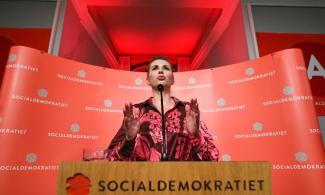
Considering the election results, Frederiksen was likely to again receive the mandate to form a new government.
Denmark’s Social Democratic Prime Minister, Mette Frederiksen, announced her plans to resign on Wednesday.
In the early hours of Wednesday, the 44-year-old told party supporters in Copenhagen that she would resign as prime minister and look at the possibility of a broad government across the political spectrum, according to ABC News.
Frederiksen added that while this form of government was rare in Denmark, she said that it was the right approach given the current crisis.
While her Social Democrats were again the strongest force, receiving 27.5 per cent of votes in what was their best result in 20 years, Frederiksen told supporters that it was clear that there was no longer “a majority behind the government in its current form.”
Considering the election results, Frederiksen was likely to again receive the mandate to form a new government.
Voters in Greenland secured the last two seats necessary for the center-left bloc of Prime Minister Mette Frederiksen to win Denmark’s general election.
The two seats in Greenland, an autonomous Danish territory, meant that the so-called red bloc of Frederiksen reached the required 90-seat majority and put her in a strong position after Tuesday's tight election.
The Greenland results came in early Wednesday and the red side’s win was based on the assumption that a vote count in Greenland would give the autonomous Danish territory’s two seats to the center-left bloc.
Siumut and Inuit Ataqatigiit, two left-leaning groups, grabbed 37.6% and 24.6% of the votes, respectively. Four of the 179 seats in Denmark's legislature, known as the Folketing, are reserved for Greenland and the Faeroe Islands, another autonomous Danish territory.
Frederiksen will formally hand in her resignation to Queen Margrethe at 11 a.m. (1000 GMT; 4 a.m. EDT) Wednesday after which talks to form a government — so-called queen rounds — are expected to begin with party leaders.
“It is also clear there is no longer a majority behind the government in its current form. Therefore, tomorrow I will submit the government’s resignation to the queen,” Frederiksen said Tuesday as she announced she would step down.
Margrethe's role is largely ceremonial, but she performs certain official functions, including attending the opening of parliament, signing new laws, formally nominating a person to head the government-formation process and appointing the prime minister. Sometimes several “queen rounds" are needed before a new government can be formed.
Troels Bøggild, an associate professor of political science at Aarhus University in western Denmark, said that Frederiksen had two options to form a government.
“Either go with the Moderates (at the center) and the Liberals and if that fails, she can crawl back to the red bloc and form a government there.
“By resigning, she shows that her election promises to build a broad center government is serious," he told The Associated Press. "If she didn’t resign and form a government in the red bloc, she would face criticism. To avoid that, she has resigned.”